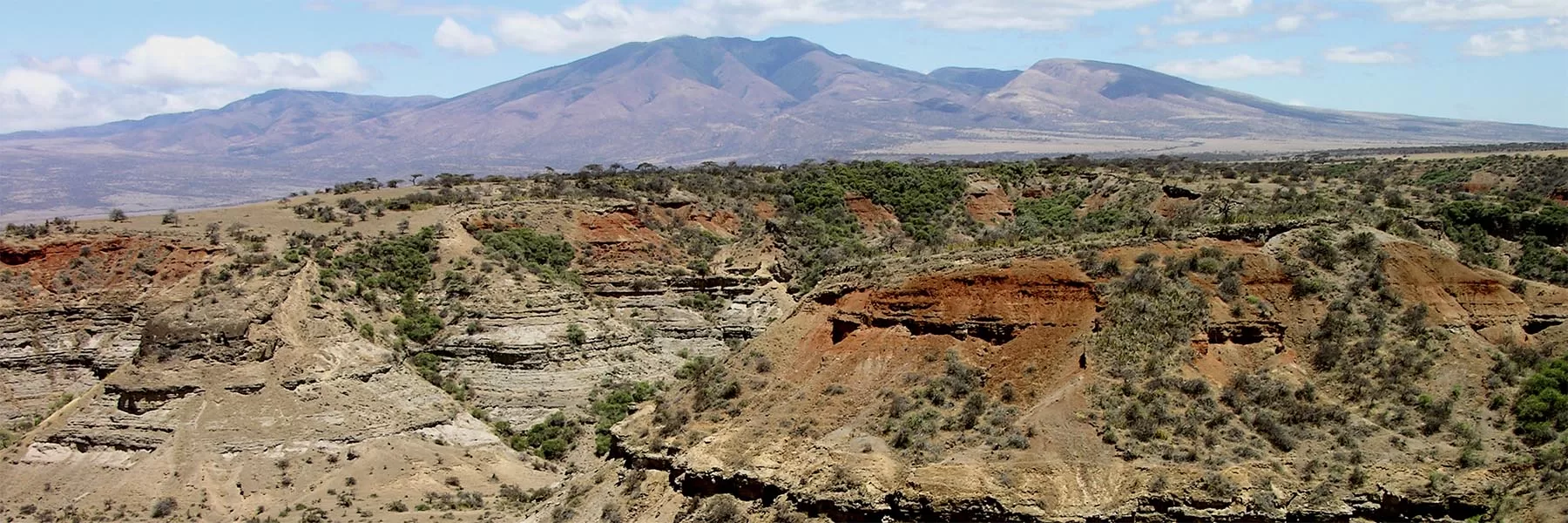Olduvai Gorge is one of the world’s most important paleoanthropological sites. Also known as Oldupai Gorge, it is situated in Tanzania and nestled between the Ngorongoro Crater and the Serengeti National Park. This site has proven valuable in furthering our understanding and study of human evolution.

The Olduvai Gorge
While visiting Tanzania, a trip to Olduvai Gorge makes for a fascinating experience. It rewards visitors with the history of mankind’s ancestors, offers an insightful museum, and boasts the most scenic vistas in the country.
Structure of the Olduvai Gorge
The Olduvai Gorge, formed thousands of years ago due to aggressive geological activity and streams, is a steep-sided ravine. It consists of two branches, having a combined length of roughly 30 miles or 48 kilometres, and is 295 feet or 90 metres deep. Although it is massive in height, it is not large enough to be classified as a canyon.
A river cuts through several layers of Olduvai Gorge to form four distinct beds. The oldest bed is estimated to be about 2 million years old. In each of the beds, paleoanthropologists have made several important revolutionary discoveries.
Significance of the Olduvai Gorge
Olduvai Gorge borrows its name from the Maasai word ‘oldupai’, which means ‘the place or area of the wild sisal’. It is because of the East African wild sisal that grows generously throughout the gorge area.
This gorge holds the earliest evidence of the existence of human ancestors. The first early human species to occupy Olduvai Gorge, as suggested by paleoanthropologists, was Homo habilis, which lived approximately 1.9 million years ago. Our known species, Homo sapiens, is estimated to have emerged roughly 30,000 years ago and seemed to reside in the gorge at least 17,000 years ago.

Olduvai stone chopping tool
Paleoanthropologists have discovered stone tools and hundreds of fossilised bones at the site that date back millions of years. This led them to conclude that humans have indeed evolved in Africa. The deposits on the sides of the gorge cover a timeline of approximately 2.1 million to 15,000 years ago. These deposits have uncovered the remains of more than 60 members of the human lineage, or hominins.
Aside from these findings, the site significantly showcases the increased development and social complexities that took place in the earliest hominins, or humans. Before the stone tools came into the picture, pieces of evidence of hunting and scavenging were also seen in the Olduvai Gorge. There is also evidence of development in social interaction and community activity that further indicates an increase in cognitive capacities in humans.
Discovery and research at Olduvai Gorge
In 1911, German physicist and archaeologist Wilhelm Kattwinkel paid a visit to the Olduvai Gorge when he visited East Africa to investigate sleeping sickness. At the site, he observed the fossil bones of an extinct three-toed horse.
German geologist Hans Reck soon became inspired by Kattwinkel’s observation and led a team to Olduvai in 1913. He discovered hominin remains and used the method of radiocarbon dating to determine the age of the fossil. The hominin remains date back to 17,000 BP (Before the present).
Various expeditions to Olduvai Gorge were planned but were cancelled abruptly due to World War I. Louis and Mary Leakey, British paleoanthropologists, visited Reck in Berlin and viewed the fossils found in Olduvai. The Leakeys became convinced that the gorge could hold evidence of stone tools. Louis Leakey also thought the remains were of a similar age to those at the Kariandusi prehistoric site in Kenya.

A plaque marking the discovery of Australopithecus
In the 1930s, the Leakeys discovered stone tools in the Olduvai Gorge and elsewhere. Their notable findings consisted of several extinct vertebrates. Among them was the first and only fossil ape skull, called the Proconsul primate, which was 25 million years old.

Paranthropus boisei fossil hominid
During the late 1950s, the Leakeys found 400 pieces of a nearly complete skull. The remains claimed to have lived 1.75 million years ago, making them the oldest hominin discovered at that point.
In 1960, among the several developments that took place during this period, the Leakeys discovered a well-preserved fossil foot that had arches. It gave credence to the theory of hominins walking on two feet. Mary Leakey and her son Jonathan Leakey uncovered another smaller human form of hominin called homo habilis, or the handy human because it seemed to be able to use tools.
The Leakeys are credited with most of the excavations and discoveries in the Olduvai Gorge.
Other discoveries
A 1.8-million-year-old skull was discovered in Olduvai by Peter Nzube, who was part of Leakey’s team in 1968. Since it had to be reconstructed from its flat state, the skull was named ‘Twiggy’.

The well-known Twiggy skull
But one of the most significant findings at Olduvai Gorge occurred in 1986. During this time span, a team of American and Tanzanian archaeologists unearthed more than 300 bones and teeth that belonged to a female, dating back to 1.8 million years ago.
Olduvai Gorge museum and monument
Today, many of the excavation sites in the gorge are still operational. In 2019, the Olduvai Gorge Monument was erected at the turnoff to Olduvai Gorge. The monument was erected to commemorate this prominent site while also attracting visitors to the Olduvai Gorge and museum.

The Olduvai Gorge monument
The monument has two large-scale models of fossil skulls created by Tanzanian artist Festo Kijo. The fossil skulls depict the two contemporary species, Homo habilis and Paranthropus boisei, that were first discovered at Olduvai Gorge.
Official guides can take visitors on a tour of Olduvai Gorge and explain the interesting history it encompasses. Located 5 km beyond the monument is the Olduvai Gorge Museum, which provides educational exhibits of the gorge and further evidence.
Olduvai Gorge has a long history and has immensely contributed to the study of human evolution. A visit to the gorge is a must for anyone travelling to Northern Tanzania.
If you loved reading this story, then subscribe to our blog here (it will ask to verify your email) to get inspiring travel stories and trivia delivered to your email. Stories about wildlife trivia, cultural experiences, curated luxury hotel lists, underrated places to travel, polar journeys and much more.











